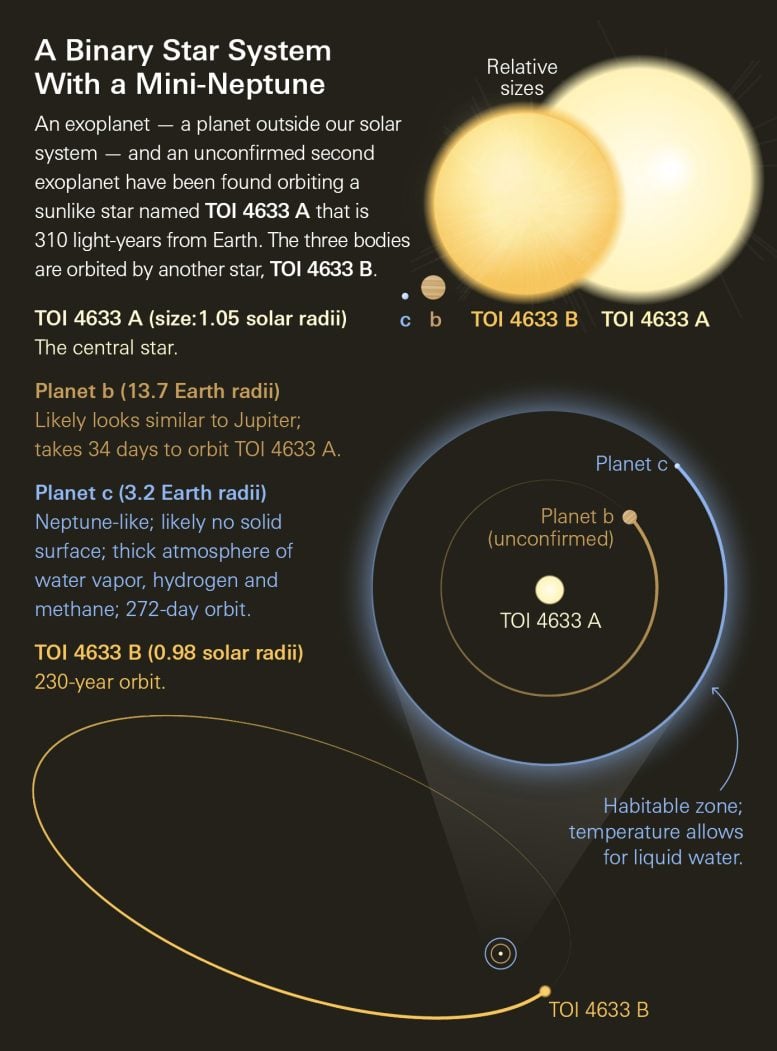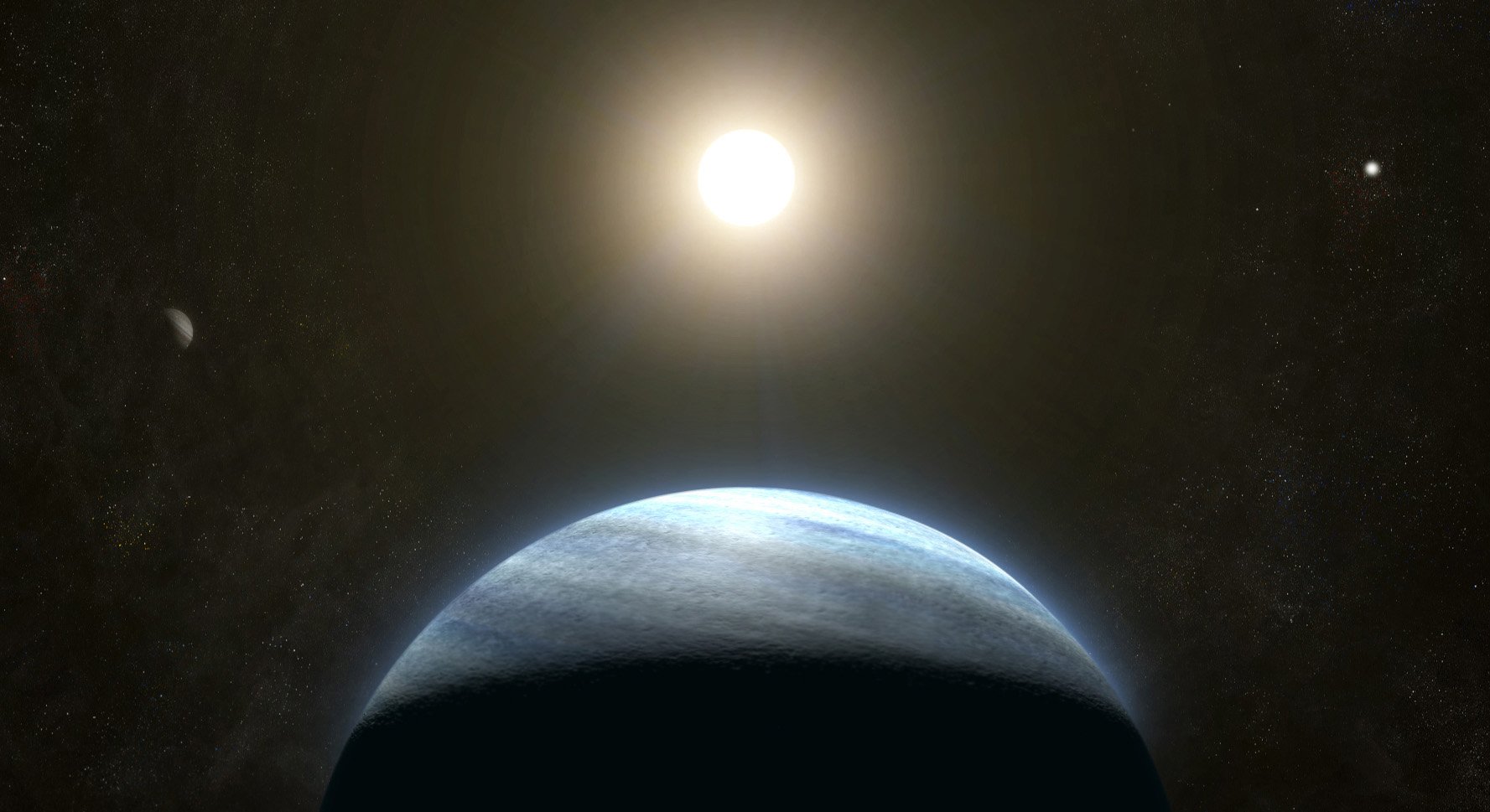A team has discovered a Neptune-like planet in a binary star system’s habitable zone, highlighting the significant role of citizen scientists in detecting exoplanets with long orbits and contributing to our understanding of multi-star planetary systems. An artist’s interpretation of TOI 4633 c, a Neptune-like exoplanet found orbiting the habitable zone of a sunlike star. The system contains a second star (right) and may also host another exoplanet (left). Credit: Ed Bell for the Simons Foundation
The newly discovered planet, identified by volunteer planet hunters and confirmed by scientists at the Flatiron Institute and their colleagues, has an exceptionally long orbit. This discovery provides valuable insights into planetary formation and stability within multi-star systems.
Astronomers and citizen scientists have identified a planet within the habitable zone of a unique star system that comprises two stars and possibly an additional
An animation of what the view from the surface of a newly discovered Neptune-like planet might look like. Credit: Ed Bell for the Simons Foundation
“Finding planets in multi-star systems is crucial for our understanding of how you can make different planets out of the same material,” says study lead author Nora Eisner, a research fellow at the Flatiron Institute’s Center for Computational Astrophysics in New York City.
Systems of stars and planets form when clouds of gas and dust begin clumping together. When a star forms alongside another star, the pair can form a binary star system. Because planets are estimated to be half as likely to form in a binary star system compared to single-star systems, Eisner says “it’s quite exciting that we found this one.”
Citizen Science Contributions
The newfound planet — formally called TOI 4633 c, but nicknamed Percival (after a character from the “Harry Potter” book series) by the scientists — was first identified by citizen scientists sifting through data collected by 
An infographic illustrating new discoveries about a multi-star, multi-planet system. Credit: Lucy Reading-Ikkanda/Simons Foundation
The citizen scientists help the astronomers sort through the enormous datasets, which are far too large for researchers to analyze on their own. To date, the project has allowed over 43,000 volunteers from 90 countries to help catalog some 25 million objects. Citizen scientists are particularly invaluable in finding long-orbit exoplanets because these objects are hard for computers to identify.
“The human brain has a really incredible ability to recognize patterns and to filter out noise,” says Eisner, who is the principal investigator of Planet Hunters TESS. “While our algorithms struggle to identify these longer-period planets, the citizen scientists don’t.”
Advanced Observations and Future Prospects
After 15 citizen scientists flagged the possible planet, Eisner and her team decided to take a closer look. A follow-up study of the star’s radial velocity — which looked for tiny wobbles in the star’s movement that reveal the gravitational tug of nearby companions — showed a potential second planet close to the star.
Further images and archival data revealed that what the scientists first thought was a single star is in fact two. The two co-orbiting stars are currently too close together to be distinguished individually from our vantage point on Earth. However, archival observations of the star collected over the past 119 years showed that the system is indeed a pair of binary stars.
The new exoplanet has the second-longest orbit of any planet discovered with TESS data and is one of only five with orbits longer than 100 days. “This planet is remarkable in many aspects,” Eisner says. “It’s remarkable in its orbit, it’s remarkable for being in the habitable zone and it’s remarkable for orbiting a bright star.”
While the scientists do think the planet is in the habitable zone, they would not advise it as a destination for your next interstellar vacation. TOI 4633 c has no solid surface, and the atmosphere is probably thick with water vapor, hydrogen, and methane. However, previous studies have shown that long-period planets are more likely to have satellites or moons, which may offer solid surfaces for life to take hold.
“If this planet were to have a moon, that moon would likely have a solid surface, which could then be a great place to find water,” Eisner says. In the future, the exoplanet could be targeted by exomoon detection campaigns given the system’s brightness and the planet’s long orbit, both of which are helpful for exomoon detection.
While scientists are keen to learn more about this system, it will be at least 30 years before the two stars are far enough apart for them to determine the exact layout of the stellar system. Confirming whether the planets orbit the same star or different ones could help improve our understanding of how long such systems can remain stable. It could also help scientists make better predictions for finding new exoplanets. Indeed, nearly half of all sunlike stars occupy multi-star systems.
“If we were able to constrain where the planets orbit, it would really offer a stepping stone to open up our understanding of exoplanet formation,” Eisner says. “It could also possibly help us someday be able to look at a star and its properties and make some guesses about what planets are potentially orbiting in that system.”
Reference: “Planet Hunters TESS. V. A Planetary System Around a Binary Star, Including a Mini-Neptune in the Habitable Zone” by Nora L. Eisner, Samuel K. Grunblatt, Oscar Barragán, Thea H. Faridani, Chris Lintott, Suzanne Aigrain, Cole Johnston, Ian R. Mason, Keivan G. Stassun, Megan Bedell, Andrew W. Boyle, David R. Ciardi, Catherine A. Clark, Guillaume Hebrard, David W. Hogg, Steve B. Howell, Baptiste Klein, Joe Llama, Joshua N. Winn, Lily L. Zhao, Joseph M. Akana Murphy, Corey Beard, Casey L. Brinkman, Ashley Chontos, Pia Cortes-Zuleta, Xavier Delfosse, Steven Giacalone, Emily A. Gilbert, Neda Heidari, Rae Holcomb, Jon M. Jenkins, Flavien Kiefer, Jack Lubin, Eder Martioli, Alex S. Polanski, Nicholas Saunders, Sara Seager, Avi Shporer, Dakotah Tyler, Judah Van Zandt, Safaa Alhassan, Daval J. Amratlal, Lais I. Antonel, Simon L. S. Bentzen, Milton K. D Bosch, David Bundy, Itayi Chitsiga, Jérôme F. Delaunay, Xavier Doisy, Richard Ferstenou, Mark Fynø, James M. Geary, Gerry Haynaly, Pete Hermes, Marc Huten, Sam Lee, Paul Metcalfe, Garry J. Pennell, Joanna Puszkarska, Thomas Schäfer, Lisa Stiller, Christopher Tanner, Allan Tarr and Andrew Wilkinson, 30 April 2024, The Astronomical Journal.
DOI: 10.3847/1538-3881/ad1d5c
Eisner encourages people interested in volunteering with Planet Hunters TESS to check out the project’s website.





















Discussion about this post